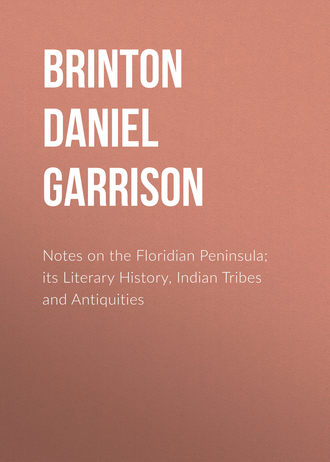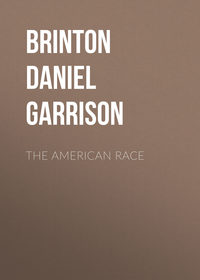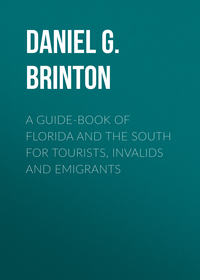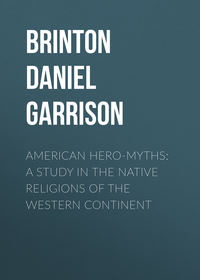 полная версия
полная версияNotes on the Floridian Peninsula; its Literary History, Indian Tribes and Antiquities
The only other delineation of the country dating from the sixteenth century that deserves notice—for those of Herrera are quite worthless—is that by Jacques Le Moyne de Morgues, published in the second volume of De Bry, which is curious as the only one left by the French colonists, though geographically not more correct than others of the day. Indeed, all of them portray the country very imperfectly. Generally it is represented as a triangular piece of land more or less irregular, indented by bays, divided into provinces Cautio, Calos, Tegeste, and others, names which are often applied to the whole peninsula. The southern extremity is sometimes divided into numerous islands by arms of the sea, and the St. Johns, when down at all, rises from mountains to the north, and runs in a southeasterly direction, nearly parallel with the rivers supposed to have been discovered by Ribaut, (La Somme, La Loire, &c.)
Now this did not at all keep pace with the geographical knowledge common to both French and Spanish towards the close of this period. The colonists under Laudonniére and afterwards Aviles himself, ascended the St. Johns certainly as far as Lake George, and knew of a great interior lake to the south; Pedro Menendez Marquez, the nephew and successor of the latter, made a methodical survey of the coast from Pensacola to near the Savannah river (from Santa Maria de Galve to Santa Helena;) and English navigators were acquainted with its general outline and the principal points along the shore.
Yet during the whole of the next century I am not aware of a single map that displays any signs of improvement, or any marks of increased information. That inserted by De Laet in his description of the New World, called Florida et Regiones Vicinæ, (1633,) is noteworthy only because it is one of the first, if not the first, to locate along his supposed route the native towns and provinces met with by De Soto. Their average excellence may be judged from those inserted in the elephantine work of Ogilby on America, (1671,) and still better in its Dutch and German paraphrases. The Totius Americæ Descriptio, by Gerhard a Schagen in the latter, is a meritorious production for that age.
No sooner, however, had the English obtained a firm footing in Carolina and Georgia, and the French in Louisiana, than a more accurate knowledge of their Spanish neighbors was demanded and acquired. The “New Map of ye North Parts of America claimed by France under ye name of Louisiana, Mississippi, Canada, and New France, with ye adjoining Territories of England and Spain,” (London, 1720,) indicates considerable progress, and is memorable as the first on which the St. Johns is given its true course, information about which its designer Herman Moll, obtained from the “Journals and Original Draughts” of Captain Nairn. His map of the West Indies contains a “Draught of St. Augustine and its Harbour,” with the localities of the castle, town, monastery, Indian church, &c., carefully pointed out; previous to it, two plans of this city had appeared, one, the earliest extant, engraved to accompany the narrative of Drake’s Voyage and Descent in 1586, and another, I know not by whose hand, representing its appearance in 1665.126
On the former of these maps, “The South Bounds of Carolina,” are placed nearly a degree south of St. Augustine, thus usurping all the best portion of the Spanish territory. This is but an example of the great confusion that prevailed for a long time as to the extent of the region called Florida. The early writers frequently embraced under this name the whole of North America above Mexico, distinguishing, as Herrera and Torquemada, between Florida explored and unexplored, (Florida conocida, Florida ignorada,) or as Christian Le Clerq, between Spanish and French and English Florida. Taking it in this extended sense, Barcia includes in his Chronology (Ensayo Cronologico de la Florida) not only the operations of the Spanish and English on the east coast of the United States, but also those of the French in Canada and the expeditions of Vasquez Coronado and others in New Mexico. Nicolas le Fer, on the other hand, ignoring the name altogether, styled the whole region Louisiana, (1718,) while the English, not to be outdone in national rapacity, laid claim to an equal amount as Carolina. De Laet127 was the first geographer who confined the name to the peninsula. In 1651 Spain relinquished her claims to all land north of 36° 30´ north lat., but it was not till the Definitive Treaty of Peace of 1763, that any political attempt was made to define its exact boundaries, and then, not with such entire success, but room was left for subsequent disputes between our government and Spain, only finally settled by the surveys of Ellicott at the close of the century.
Neither Guillaume de l’Isle nor M. Bellin, both of whom etched maps of Florida many years after the publication of that of Moll, seems to have been aware of his previous labors, or to have taken advantage of his more extensive information. In the gigantic Atlas Nouveau of the former, (Amsterdam, 1739,) are two maps of Florida, evidently by different hands. The one, Tabula Geographica Mexico et Floridæ, gives tolerably well the general contour of the peninsula, and situates the six provinces of Apalacha mentioned by Bristock; the other, Carte de la Louisiane et du Cours du Mississippi, is an enlarged copy with additions of that published five years previous in the fifth volume of the Voyages au Nord, on which is given the route of De Soto. Bellin’s Carte des Costes de la Nouvelle France suivant les premiéres Decouvertes is found in Charlevoix’s Nouvelle France and is of little worth.
The map of “Carolina, Florida, and the Bahama Islands,” that accompanies Catesby’s Natural History of those regions, is not so accurate as we might expect from the opportunities he enjoyed. The peninsula is conceived as a nearly equilateral triangle projecting about two hundred and sixty miles towards the south. Like other maps of this period, it derives its chief value from locating Indian and Spanish towns.
The dangerous navigation of the Keys had necessitated their examination at an early date. In 1718, Domingo Gonzales Carranza surveyed them, as well as some portion of the northern coast, with considerable care. His notes remained in manuscript, however, till 1740, when falling into the hands of an Englishman, they were translated and brought out at London under the title, “A Geographical Description of the Spanish West Indies.” But how inefficient the knowledge of these perilous reefs remained for many years is evident on examining the marine chart of the Gulf of Mexico, by Tomas Lopez and Juan de la Cruz, in 1755. The seafaring English, when they took possession of the country, made it their first duty to get the most exact possible charts of these so important points. No sooner had the treaty been signed than the Board of Admiralty dispatched G. Gauld, a capable and energetic engineer to survey the coasts, islands, and keys, east and south of Pensacola. In this employment he spent nearly twenty years, from 1764 to 1781, when he was taken prisoner by the Spanish, and shortly afterwards died. The results were not made public till 1790, when they appeared under the supervision of Dr. Lorimer, and, in connection with the Gulf Pilot of Bernard Romans, and the sailing directions of De Brahm, both likewise engineers in the British service, employed at the same time as Gauld, constituted for half a century the chief foundation for the nautical charts of this entrance to the Gulf.
Among the writers of the last century who did good service to American geography, Thomas Jefferys, Geographer to his Majesty, deserves honorable mention. Besides his more general labors, he edited, in 1763, the compilation of Roberts, and some years after the Journal of the elder Bartram; to both he added a general map of the region under consideration, “collected and digested with great care and labor from a number of French and Spanish charts,” taken on prize ships, correct enough as far as regards the shore, but the interior very defective; a plan of Tampa Bay; and one of St. Augustine and harbor, giving the depth of water in each, and on the latter showing the site of the sea wall.
Besides those in the Atlas of Popple, of 1772, the following maps, published during the last century, may be consulted with advantage:
Carolinæ, Floridæ nec-non Insularum Bajamensium delineatio, Nuremberg, 1775.
Tabulæ Mexicanæ et Floridæ, terrarum Anglicarum, anteriarum Americæ insularum. Amstelodami, apud Petrum Schenck, circ. 1775.
A Map of the Southern British Colonies, containing the Seat of War in N. and S. Carolina, E. and W. Florida. By Bernard Romans. London, 1776.
Plan of Amelia Island and Bar, surveyed by Jacob Blaney in 1775. London, 1776.
Plan of Amelia Island and Bar. By Wm. Fuller. Edited by Thomas Jefferys. London, 1776.
Plano de la Ciudad y Puerto de San Augustin de la Florida. Por Tomas Lopez. Madrid, 1783.
Nothing was done of any importance in this department during the second Spanish supremacy, but as soon as the country became a portion of the United States, the energy both of private individuals and the government rapidly increased the fund of geographical knowledge respecting it.
The first map published was that of Vignoles, who, an engineer himself, and deriving his facts from a personal survey of the whole eastern coast from St. Marys river to Cape Florida, makes a very visible improvement on his predecessors.
The canal contemplated at this period from the St. Johns or St. Marys to the Gulf gave occasion to levellings across the peninsula at two points, valuable for the hypsometrical data they furnish. Annexed to the report (February, 1829,) is a “Map of the Territory of Florida from its northern boundary to lat. 27° 30´ N. connected with the delta of the Mississippi,” giving the features of the country and separate plans of the harbors and bays.
The same year J. R. Searcy issued a map of the territory, “constructed principally from authentic documents in the land office at Tallahassie,” favorably mentioned at the time.128
The map prefixed to his View of West Florida, and subsequently to his later work, by Colonel Williams, largely based on his own researches, is a good exposition of all certainly known at that period about the geography of the country. Cape Romans is here first distinguished as an island; Sharks river is omitted; and Lake Myaco or Okee-chobee is not down, “simply,” says the author, “because I can find no reason for believing its existence!” Unparalleled as such an entire ignorance of a body of water with a superficies of twelve hundred square miles, in the midst of a State settled nigh half a century before any other in our Union, which had been governed for years by English, by Spanish, and by Americans, may be, it well illustrates the impassable character of those vast swamps and dense cypresses known as the Everglades; an impenetrability so complete as almost to justify the assertion of the State engineer, made as late as 1855: “These lands are now, and will continue to be, nearly as much unknown as the interior of Africa or the mountain sources of the Amazon.”129
What little we know of this Terra Incognita, is derived from the notes of officers in the Indian wars, and the maps drawn up for the use of the army. Among these, that issued by the War Department at the request of General Taylor, in 1837, embracing the whole peninsula, that prefixed to Sprague’s History, which gives the northern portion with much minuteness, and the later one, in 1856, of the portion south of Tampa Bay, are the most important. The latter gives the topography of the Everglades and Big Cypress as far as ascertained.
While annual explorations are thus throwing more and more light on the interior of the peninsula, the United States Coast Survey, now in operation, will definitely settle all kindred questions relative to its shores, harbors, and islands; and thus we may look forward to a not distant day when its geographical history will be consummated.
CHAPTER II.
THE APALACHES
Derivation of the name.—Earliest notices of.—Visited and described by Bristock in 1653.—Authenticity of his narrative.—Subsequent history and final extinction.
Among the aboriginal tribes of the United States perhaps none is more enigmatical than the Apalaches. They are mentioned as an important nation by many of the early French and Spanish travellers and historians, their name is preserved by a bay and river on the shores of the Gulf of Mexico, and by the great eastern coast range of mountains, and has been applied by ethnologists to a family of cognate nations that found their hunting-grounds from the Mississippi to the Atlantic and from the Ohio river to the Florida Keys; yet, strange to say, their own race and place have been but guessed at. Intimately connected both by situation and tradition with the tribes of the Floridian peninsula, an examination of the facts pertaining to their history and civilization is requisite to a correct knowledge of the origin and condition of the latter.
The orthography of the name is given variously by the older writers, Apahlahche, Abolachi, Apeolatei, Appallatta, &c., and very frequently without the first letter, Palaxy, Palatcy. Daniel Coxe, indeed, fancifully considered this first vowel the Arabic article a, al, prefixed by the Spaniards to the native word.130 Its derivation has been a questio vexata among Indianologists; Heckewelder131 identified it with Lenape or Wapanaki, “which name the French in the south as easily corrupted into Apalaches as in the north to Abenakis,” and other writers have broached equally loose hypothesis. Adair132 mentions a Chikasah town, Palacheho, evidently from the same root; but it is not from this tongue nor any of its allies, that we must explain its meaning, but rather consider it an indication of ancient connections with the southern continent, and in itself a pure Carib word. Apáliché in the Tamanaca dialect of the Guaranay stem on the Orinoco signifies man,133 and the earliest application of the name in the northern continent was as a title of the chief of a country, l’homme par excellence,134 and hence, like very many other Indian tribes (Apaches, Lenni Lenape, Illinois,) his subjects assumed by eminence the proud appellation of The Men. How this foreign word came to be imported will be considered hereafter. Among the tribes that made up the confederacy, probably only one partook of the warring and energetic blood of the Caribs; or it may have been assumed in emulation of a famous neighbor; or it may have been a title of honor derived from the esoteric language of a foreign priesthood, instances of which are not rare among the aborigines.
In the writings of the first discoverers they uniformly hold a superior position as the most polished, the most valorous, and the most united tribe in the region where they dwelt. The fame of their intrepidity reached to distant nations. “Keep on, robbers and traitors,” cried the Indians near the Withlacooche to the soldiers of De Soto, “in Apalache you will receive that chastisement your cruelty deserves.” When they arrived at this redoubted province they found cultivated fields stretching on either hand, bearing plentiful crops of corn, beans, pumpkins, cucumbers, and plums,135 whose possessors, a race large in stature, of great prowess, and delighting in war, inhabited numerous villages containing from fifty to three hundred, spacious and commodious dwellings, well protected against hostile incursions. The French colonists heard of them as distinguished for power and wealth, having good store of gold, silver, and pearls, and dwelling near lofty mountains to the north; and Fontanedo, two years a prisoner in their power, lauds them as “les meilleurs Indiens de la Floride,” and describes their province as stretching far northward to the snow-covered mountains of Onagatano abounding in precious metals.136
About a century subsequent to these writers, we find a very minute and extraordinary account of a nation called Apalachites, indebted for its preservation principally to the work of the Abbé Rochefort. It has been usually supposed a creation of his own fertile brain, but a careful study of the subject has given me a different opinion. The original sources of his information may be entirely lost, but that they actually existed can be proved beyond reasonable doubt. They were a series of ephemeral publications by an “English gentleman” about 1656, whose name is variously spelled Bristol, Bristok, Brigstock, and Bristock, the latter being probably the correct orthography. He had spent many years in the West Indies and North America, was conversant with several native tongues, and had visited Apalacha in 1653. Besides the above-mentioned fragmentary notes, he promised a complete narrative of his residence and journeys in the New World, but apparently never fulfilled his intention. Versions of his account are found in various writers of the age. The earliest is given by Rochefort137, and was translated with the rest of the work of that author by Davies138, who must have consulted the original tract of Bristock as he adds particulars not found in the Abbé’s history. Others are met with in the writings of the Geographus Ordinarius, Nicolas Sanson d’ Abbeville139, in the huge tomes of Ogilby140 and his high and low Dutch paraphrasers Arnoldus Montanus141 and Oliver Dapper,142 in Oldmixon’s history,143 quite fully in the later compilation that goes under the name of Baumgarten’s History of America,144 and in our own days has been adverted to by the distinguished Indianologist H. R. Schoolcraft in more than one of his works. It consists of two parts, the one treating of the traditions, the other of the manners and customs of the Apalachites. In order to place the subject in the clearest light I shall insert a brief epitome of both.
The Apalachites inhabited the region called Apalacha between 33° 25´ and 37° north latitude. By tradition and language they originated from northern Mexico, where similar dialects still existed.145 The Cofachites were a more southern nation, scattered at first over the vast plains and morasses to the south along the Gulf of Mexico (Theomi), but subsequently having been reduced by the former nation, they settled a district called Amana, near the mountains of Apalacha, and from this circumstance received the name Caraibe or Carib, meaning “bold, warlike men,” “strangers,” and “annexed nation.” In after days, increasing in strength and retaining their separate existence, they asserted independence, refused homage to the king of Apalacha, and slighted the worship of the sun. Wars consequently arose, extending at intervals over several centuries, resulting in favor of the Cofachites, whose dominion ultimately extended from the mountains in the north to the shores of the Gulf and the river St. Johns on the south. Finding themselves too weak to cope openly with such a powerful foe, the Apalachites had recourse to stratagem. Taking advantage of a temporary peace, their priests used the utmost exertions to spread abroad among their antagonists a religious veneration of the sun and a belief in the necessity of an annual pilgrimage to his sacred mountain Olaimi in Apalacha. So well did their plan succeed, that when at the resumption of hostilities, the Apalachites forbade the ingress of all pilgrims but those who would do homage to their king, a schism, bitter and irreconcileable, was brought about among the Cofachites. Finally peace was restored by a migration of those to whom liberty was dearer than religion, and a submission of the rest to the Apalachites, with whom they became amalgamated and lost their identity. Their more valiant companions, after long wanderings through unknown lands in search of a home, finally locate themselves on the southern shore of Florida. Islanders from the Bahamas, driven thither by storms, tell them of lands, fertile and abounding in game, yet uninhabited and unclaimed, lying to the southwards; they follow their advice and direction, traverse the Gulf of Florida, and settle the island of Ayay, now Santa Cruz. From this centre colonies radiated, till the majority of the islands and no small portion of the southern mainland was peopled by their race.
Such is the sum of Bristock’s singular account. It is either of no credibility whatever, or it is a distorted version of floating, dim traditions, prevalent among the indigenes of the West Indies and the neighboring parts of North America. I am inclined to the latter opinion, and think that Bristock, hearing among the Caribs rumors of a continent to the north, and subsequently finding powerful nations there, who, in turn, knew of land to the south and spoke of ancient wars and migrations, wove the fragments together, filled up the blanks, and gave it to the world as a veritable history. To support this view, let us inquire whether any knowledge of each other actually existed between the inhabitants of the islands and the northern mainland, and how far this knowledge extended.
The reality of the migration, though supported by some facts, must be denied of the two principal races, the Caribs and Arowauks, who peopled the islands at the time of their discovery. The assertions of Barcia, Herrera, and others that they were originally settled by Indians from Florida have been abundantly disproved by the profound investigations of Alphonse D’Orbigny in South America.146 On the other hand, that the Cubans and Lucayans had a knowledge of the peninsula not only in the form of myths but as a real geographical fact, even having specific names in their own tongues for it (Cautio, Jaguaza), is declared by the unanimous voice of historians.
The most remarkable of these myths was that of the fountain of life, placed by some in the Lucayos, but generally in a fair and genial land to the north.147 From the tropical forests of Central America to the coral-bound Antilles the natives told the Spaniards marvellous tales of a fountain whose magic waters would heal the sick, rejuvenate the aged, and confer an ever-youthful immortality. It may have originated in a confused tradition of a partial derivation from the mainland and subsequent additions thence received from time to time, or more probably from the adoration of some of the very remarkable springs abundant on the peninsula, perchance that wonderful object the Silver Spring,148 round which I found signs of a dense early population, its virtues magnified by time, distance, and the arts of priests. We know how intimately connected is the worship of the sun with the veneration of water; heat typifying the masculine, moisture the feminine principle. The universality of their association in the Old World cosmogonies and mythologies is too well-known to need specification, and it is quite as invariable in those of the New Continent. That such magnificent springs as occur in Florida should have become objects of special veneration, and their fame bruited far and wide, and handed down from father to son, is a most natural consequence in such faiths.149
Certain it is that long before these romantic tales had given rise to the expeditions of De Leon, Narvaez, and De Soto, many natives of the Lucayos, of Cuba, even of Yucatan and Honduras,150 had set out in search of this mystic fount. Many were lost, while some lived to arrive on the Floridian coast, where finding it impossible either to proceed or return, they formed small villages, “whose race,” adds Barcia,151 writing in 1722, “is still in existence” (cuia generacion aun dura). This statement, which the cautious investigator Navarrete confirms,152 seems less improbable when we reflect that in after times it was no uncommon incident for the natives of Cuba to cross the Gulf of Florida in their open boats to escape the slavery of the Spaniards,153 that the Lucayans had frequent communication with the mainland,154 that the tribes of South Florida, as early as 1695, carried on a considerable trade with Havana,155 that the later Indians on the Suwannee would on their trading excursions not only descend this river in their large cypress canoes, but proceed “quite to the point of Florida, and sometimes cross the Gulph, extending their navigations to the Bahama islands and even to Cuba,”156 and finally that nothing was more common to such a seafaring nation as the Caribs than a voyage of this length.157
Another remarkable myth, which certainly points for its explanation to an early and familiar intercourse between the islands and the mainland, is the singular geognostic tradition prevalent among the Lucayans, preserved by Peter of Anghiera, to the effect that this archipelago was originally united to the continent by firm land.158 Doubtless it was on such grounds that the Spaniards concluded that they owed their original settlement to migrations from the Floridian peninsula.









